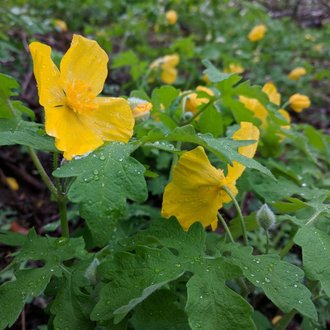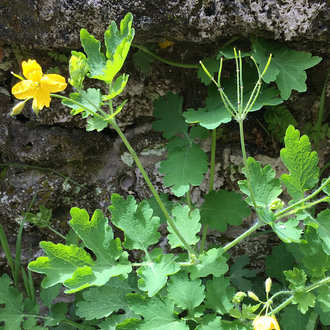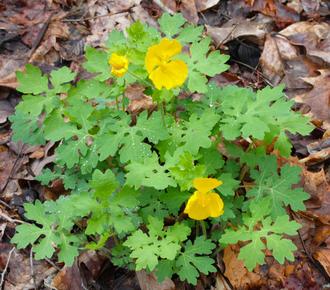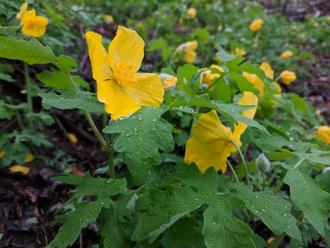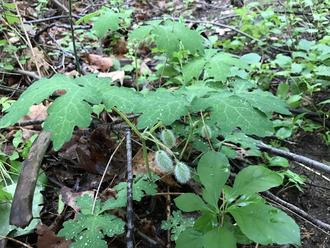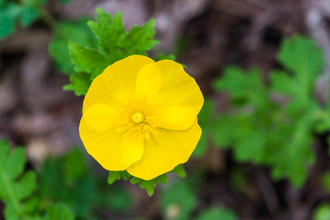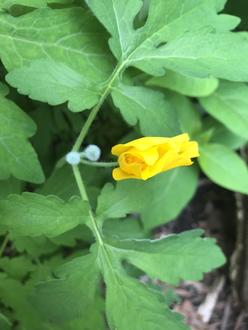Celandine Poppy (Stylophorum diphyllum (Michx.) Nutt.)
Also known as woods-poppy, wood poppy.
↑Summary
A woodland perennial native to the east-central U.S.; uncommon in its native range but planted in gardens and sometimes escaping into the wild.
↑Range - Expand
| Legend | Color |
| Native | |
| Introduced | |
| Native or Not Present | |
| Native or Expanded | |
| Introduced or Not Present | |
| Native or Introduced |
This map is based on our research. We have checked its accuracy to Level 3 ecoregions. Although this plant occurs somewhere in each of these regions, it may only occur in a small part of some or all of them.
↑Similar Plants
↑Habitat
Found in moist to mesic deciduous forests, especially those over calcareous bedrock. Habitats include lower slopes of ravines and bluffs, and rocky streambanks. Growth is best in dappled sunlight and mesic conditions, but it can tolerate heavy shade and consistently wet soil. However, intolerant of flooding, and can be damaged by flooding as short as a few days, or even shorter flooding that causes deposition of sediment.
Often outcompeted by the two invasive plants garlic mustard (Alliaria petiolata) and Japanese stiltgrass (Microstegium vimineum), which frequently invade habitats where it occurs. It is also sensitive to trampling and soil compaction. These factors contribute to this species often being limited to higher-quality, intact natural habitats where these species are not established.
Paradoxically, humans have both threatened this species in its native range and habitats, and allowed it to expand its range and colonize new, anthropogenic habitats.
Often thrives in suburban gardens, where humans create higher-light conditions, richer, more consistently moist conditions, and/or better drainage than would be found in the wild. Sometimes establishes in small woodland fragments in parks.
↑Life Cycle
This species is a long-lived perennial.
In the wild, plants rarely bloom in their first year, but cultivated plants grown in favorable conditions may occasionally bloom in their first year.
Plants usually bloom in late spring to early summer, with a bloom period of about 3-4 weeks. Flowers may be pollinated by insects, but are also self-fertile.
Seeds ripen and are dropped to the ground usually in the month following flowering, and are distributed by ants, and the seeds remain dormant over the winter and germinate in the subsequent year. We could not find verification of how long the seeds remain viable, but researchers have stated that it is likely that this species does not persist in the seed bank. Establishment of new individuals through seeding is usually sporadic, and this species persists in stable populations in large part to a high survival rate of already-established plants.
The foliage usually persists throughout the year, but in dry years the foliage will die down and the plant will go dormant in the heat of summer.
Plants do not propagate vegetatively, but do increase in vigor, with one plant in time growing up to 10 flowering stems. Individual plants can easily live to 10 years of age, possibly to 20 years or longer.
↑Faunal Associations
Not much is known about this plant's association with insects, but it likely does not support many insects relative to other native plants. The flowers lack nectar and provide only pollen to insect visitors. Beetles of the Acmaeodera genus have been recorded visiting the flowers; we found many sources saying flowers are likely also visited by bees and flies, but no more specifics of such visitors.
The seeds, which have fatty appendages, are primarily distributed by ants, and are also eaten by mice.
The foliage is toxic to and generally ignored by most mammals and may also be toxic to most insects as well, as it is rarely shows evidence of insect damage. The lack of close relatives of this plant, and its relative scarcity, may both reduce the likelihood of insects evolving the ability or preference to eat this plant. Ungulates, including deer, will occasionally browse this plant, however, and can damage it considerably even with small amounts of browsing; such browsing may be a limiting factor in this plant's ability to survive in some habitats.
↑Control
In much of its range, this species is uncommon and sometimes even treated as locally endangered and warranting protection. However, it can rarely form large monocultures, usually when it has been introduced outside of its native range. In these circumstances it is relatively easy to control due to its slow reproduction rate.
Plants can be removed by uprooting them, and then leaving them in place to die. It is best to remove plants before they set seed, but due to its slow reproduction by seed, it will be greatly reduced by uprooting plants even after they set seed.
↑Uses
Occasionally used as a landscaping plant, where it is valued for its showy yellow flowers and ability to flower well even in dense shade. It also transplants well, which facilitates its use as a garden plant, as well as its sharing between gardeners. It has gathered favor in recent years as a "native" plant, but its use in native plant gardens and ecological restoration projects can sometimes be misguided. It is often planted in areas well outside its native range, and it lacks the benefits of supporting numerous insects that most native plants bring.
↑Related Plants
This species is the only member of its genus in North America. The broader Chelidonieae tribe of the Papaveroideae subfamily of the Papaveraceae family contains only one species native to North America, bloodroot (Sanguinaria canadensis), but it also contains several introduced species, the widespread and similar-looking greater celandine (Chelidonium majus), and the three plants blackspot hornpoppy (Glaucium corniculatum), yellow hornpoppy (Glaucium flavum), and plume poppy (Macleaya cordata), all of which have spotty distributions throughout North America, established in the wild only at isolated sites.
Of these plants, the Celandine Poppy is probably closest related to Chelidonium and not particularly closely related to any of the others.
↑Links & External Resources
• Stylophorum diphyllum (Celandine Poppy) | Illinois Wildflowers (About This Site)
• Stylophorum diphyllum (Celandine Poppy) | USDA PLANTS Database (About This Site)
• Celandine Poppy | iNaturalist (About This Site)
• Stylophorum diphyllum (Celandine Poppy) | Missouri Botanical Garden Plant Finder (About This Site)
• Stylophorum diphyllum | Biota of North America Project (BONAP) (About This Site)
• Stylophorum diphyllum | NatureServe Explorer (About This Site)
• Stylophorum diphyllum | Flora of North America (About This Site)
• Stylophorum diphyllum | Missouri Plants (About This Site)
• Celandine Poppy | Maryland Biodiversity Project (About This Site)
• Stylophorum diphyllum (Michaux) Nuttall (Celandine Poppy, Wood Poppy) | Digital Atlas of the Virginia Flora (About This Site)



